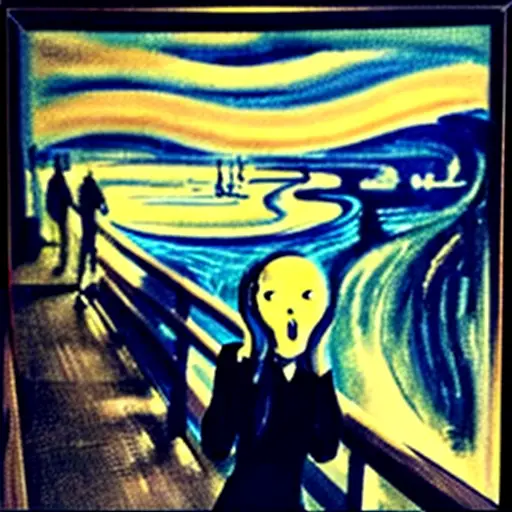Unveiling the Enigma: The Origins and Context of 'The Scream' takes us on a wild journey through the mind-boggling world of Edvard Munch's iconic masterpiece. As we delve into the depths of this haunting artwork, we can't help but wonder, what on earth is going on in that guy's head? Is he being chased by a horde of angry seagulls? Did he just realize he left the oven on? Or perhaps he's just received his credit card bill after a shopping spree gone horribly wrong. Whatever the case may be, 'The Scream' has become the ultimate symbol of existential angst, capturing the universal feeling of utter despair when you realize you've run out of chocolate on a rainy day.
One interesting fact about 'The Scream' painting by Edvard Munch is that its meaning goes beyond a simple depiction of fear or anguish. While many interpret the central figure's open-mouthed scream as a representation of existential dread or psychological torment, Munch himself provided a more personal explanation. He described the inspiration behind the painting as a moment when he was walking along a path and felt overwhelmed by a blood-red sunset, which he perceived as a scream passing through nature. This suggests that the painting is not only a reflection of the artist's inner turmoil but also a portrayal of the intense emotions evoked by the natural world.
In the enigmatic world of 'The Scream', every brushstroke and color choice holds a hidden message, waiting to be deciphered. As we embark on the journey of decoding the visual elements in this iconic artwork, we are confronted with a cacophony of symbolism. The blood-red sky, swirling like a vortex of chaos, mirrors the turmoil within the protagonist's soul. The figure's contorted face, frozen in a silent scream, speaks volumes about the overwhelming anxiety and existential dread that plague us all. The bridge, ominously arching over the abyss, represents the fragile barrier between sanity and madness. 'The Scream' is a visual symphony of despair, a timeless reminder that beneath our seemingly composed exteriors, we all carry a scream within us, longing to be heard.

Psychological Interpretations: Exploring the Inner Turmoil in 'The Scream' takes us on a deep dive into the tumultuous world of the human psyche as depicted in Edvard Munch's masterpiece. At first glance, the figure in the painting appears to be in a state of sheer terror, but upon closer examination, we begin to unravel the layers of meaning hidden within. The distorted face, with its wide-open mouth and hollow eyes, reflects the intense emotional anguish experienced by the artist. It serves as a visual representation of the inner turmoil that plagues us all at times, capturing the universal struggle to find meaning in an often chaotic and overwhelming world.
The blood-red sky and the swirling patterns in the background further contribute to the psychological interpretation of 'The Scream'. The vibrant hues and chaotic brushstrokes evoke a sense of unease and instability, mirroring the protagonist's internal state. The sky, tinged with a sense of impending doom, suggests a world on the brink of collapse, amplifying the feelings of anxiety and despair.
Moreover, the solitary figure standing on the bridge adds another layer of psychological complexity to the painting. The bridge, often symbolizing a connection between two worlds, represents the fragile threshold between sanity and madness. It serves as a metaphorical representation of the individual's struggle to maintain their mental equilibrium in the face of overwhelming emotions.
'The Scream' is a powerful testament to the human condition, capturing the raw intensity of our innermost fears and anxieties. It serves as a reminder that beneath our composed exteriors, we all grapple with our own demons. Munch's masterpiece invites us to confront and explore our own inner turmoil, fostering a deeper understanding of the complexities of the human mind and the shared experiences that unite us all.
The famous painting 'The Scream' by Edvard Munch is often interpreted as a representation of existential angst and the human condition. However, a fun fact about this iconic artwork is that the figure in the painting is actually screaming because it encountered a group of angry seagulls who stole its ice cream cone!
Cultural Impact and Enduring Significance: 'The Scream' as a Reflection of Human Existence showcases the profound impact that Edvard Munch's masterpiece has had on the art world and beyond. Beyond its initial creation, 'The Scream' has transcended time and culture, becoming an enduring symbol of the human condition. Its universal themes of anxiety, despair, and existential angst resonate with people from all walks of life, transcending language and cultural barriers. The painting's ability to evoke a visceral response in viewers speaks to its timeless relevance, as it continues to serve as a poignant reflection of the human experience. 'The Scream' has become an iconic image, inspiring countless artists, writers, and filmmakers to explore the depths of human emotion and the complexities of existence. Its enduring significance lies in its ability to capture the essence of our shared humanity, reminding us that we are all united in our struggles and fears, regardless of time or place.